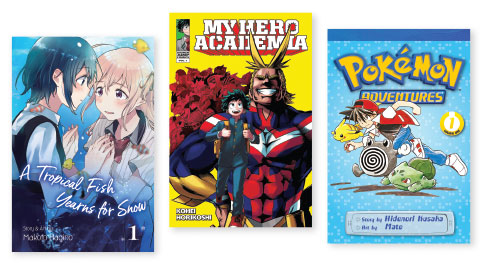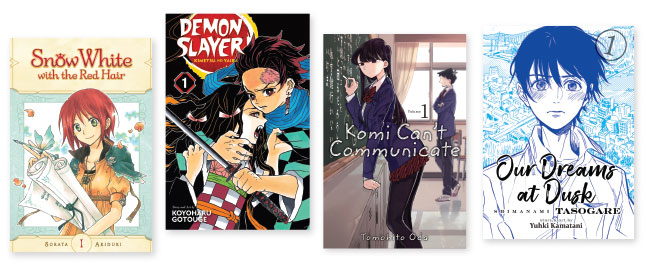More and More Manga: An Updated Primer on Japanese Comic Books and Graphic Novels
New types of manga have proliferated—and students can’t get enough. This overview of genres, publishers, formats, and more, will help get you up to date.

Publishing is like any other business: If the public likes what you’re selling, give them more! That may account for manga’s skyrocketing sales over the past two years, with sales in bookstores up 160 percent in 2021 alone. New genres and formats have proliferated, too—and students can’t get enough. This updated, nuts-and-bolts primer, looking at the genres, publishers, formats, and more, will help you get up to date.
“Manga” is simply the Japanese word for “comics,” and in English-speaking countries it means “comics from Japan.” Many people are familiar with the basic four manga audience demographics: shonen (teenage boys), shoujo (teenage girls), seinen (young men), and josei (young women). These broad terms refer to the types of magazines where the manga were originally serialized, but it can make more sense for U.S. readers to think in terms of genre first.
The slice-of-life manga “Yotsuba&!,” for instance, is popular with readers of all ages, but it runs in a seinen magazine in Japan. Similarly, shonen romances such as “Your Lie in April” may appeal to all readers. Shonen stories are usually told from a boy’s point of view and a shoujo story from a girl’s, but there are exceptions in both genres.
The dominant genre is action/adventure stories, with the titles “My Hero Academia,” “Demon Slayer: Kimetsu no Yaiba,” and “Toilet-Bound Hanako-Kun” among the best sellers. Many of the top titles have a supernatural or fantasy element.

Romance is another perennial genre, and while harem comedies (in which the male protagonist is surrounded by beautiful women) and high school sweetheart narratives haven’t gone anywhere, the variety of stories has expanded. We’re seeing more slice-of-life romances, such as “Komi Can’t Communicate” and “Your Lie in April,” along with romances with fantasy settings, such as “Snow White With the Red Hair.”
As for LGBTQ+ stories, while there’s still an audience for yaoi (male/male romances written for female readers), high school narratives often take a more realistic approach. The shoujo romance “A Tropical Fish Yearns for Snow,” for instance, follows two high school girls who become friends but have deeper feelings for each other, while “Our Dreams at Dusk” is about a teen boy who finds a welcoming gay community after being outed and bullied at school. Female/female romances are labeled yuri, while male/male romances are often referred to as “boys love,” sometimes abbreviated to BL.
Isekai (literally, “another world”) is a newer genre that has just about taken over the fantasy category. In these, the protagonist dies or is whisked away to a new world that usually resembles a video game. In the “reverse isekai” genre, fantasy creatures find themselves in our world and must adjust to everyday life. Most isekai manga are pitched at older teenagers and adults, but a handful are appropriate for younger teens.
Publishers
Viz Media, the largest manga publisher in North America, is co-owned by two Japanese publishers, Shueisha and Shogakukan, so it has a direct pipeline to some of the most popular titles. Shueisha’s Weekly Shonen Jump is the top-selling manga magazine in Japan, and Viz publishes series from that and other Shueisha magazines digitally on its Shonen Jump site (viz.com/shonen-jump) and in print under its Shonen Jump imprint. Weekly Shonen Jump’s target demographic is teenage boys, but it also has a substantial female readership. A typical Shonen Jump story, such as “My Hero Academia,” includes plenty of action, a hero striving for a goal, and a supporting cast of friends and enemies.

Kodansha Comics, the second largest U.S. manga publisher, is owned by Kodansha, Japan’s biggest publisher. The Kodansha imprint Vertical Comics releases edgier, more literary titles but also kid-friendly stories such as “Chi’s Sweet Home.” Yen Press places a heavy emphasis on light novels and publishes a lot of isekai and yuri series. Nonetheless, its most popular title is “Toilet-Bound Hanako-Kun,” a shonen action manga.
Seven Seas is a fast-growing publisher with several solid titles for tweens and teens, including LGBTQIA+ romances, fantasy, and classic older series. And smaller publishers include Square Enix, Udon, and Denpa, as well as U.S. companies that release manga such as Dark Horse, Drawn and Quarterly, and Fantagraphics.
Formats
The standard format for American manga is still paperback, about five-by-seven inches, 200 pages, with a color cover and black-and-white interior. Most publishers keep the right-to-left orientation of the Japanese originals. Back matter may include translator’s notes, a guide to Japanese honorifics, and a personal message from the creator. Publishers also may use a slightly larger trim size for multivolume omnibuses, mature titles, and books that are special in some way.
Omnibuses offer more manga for the buyer’s buck and save space on shelves. Viz and Kodansha often re-release older series as omnibuses, binding up two or three of the original volumes, while Seven Seas frequently uses the format for newly licensed series.
Beyond the omnibus is the prestige edition, often called a “perfect edition.” These special editions are often published in Japan to mark the anniversary of a classic series and are then picked up by U.S. publishers. Perfect editions are larger and thicker than the original volumes and may be hardcover or have a deluxe paperback format. They also include bonus material, such as color pages or extra stories.
Spin-offs, anime, and light novels
Keeping up with audience demand for manga has resulted in spin-offs and prose novels based on popular properties. “My Hero Academia,” for example, has four spinoffs. Different types of media have proliferated, too. One newer medium is light novels, which provide escape reading that often has similar themes to manga; fantasy and isekai are the two big genres. Like manga, light novels often have spin-offs, and sometimes there will be several different manga adaptations and even a video game. Yen Press and Seven Seas have their own light novel imprints (Yen On and Airship, respectively).
Finding and sampling
All the major publishers have websites with calendars of upcoming releases and information about the books. In addition, Viz offers previews of many series, and in the case of Shonen Jump series, posts the first three and the most recent three chapters online. The Manga Plus website also offers the first and last three chapters of many titles and Kodansha offers some previews as well.
These days, legal digital manga is also widely available; Japanese publishers have embraced it in part to combat rampant piracy. Readers can find a wide array of titles on official digital services, either for free or at a reasonable cost, and publishers usually list the digital options on their websites.
With so much to choose from, there’s something for everyone. Now that you’ve got the basics, it’s time to start reading!
Content RatingMost manga published in North America carries age ratings for a good reason: It’s not always obvious who the audience is from the cover. Manga ratings should be treated like movie ratings, rather than reading levels. That said, a low rating doesn’t guarantee wholesome content. Many teen-rated manga include body humor and mildly sexual situations, along the lines of a boy walking in on a girl in the shower. Some romances, particularly older titles, portray boys pressuring girls into uncomfortable situations. Inappropriate relationships between teenagers and adults, or between siblings or stepsiblings, are sometimes hinted at and sometimes explicit. Bullying is a frequent plot point, and suicide is not uncommon. Popular action-adventure titles can have a fair amount of violence. Some publishers will specify the reason for the rating, and free previews are also helpful. Later series volumes may have more mature content than earlier ones. |
Brigid Alverson founded the blog “Good Comics for Kids” (slj.com/goodcomics).
Add Comment :-
RELATED
The job outlook in 2030: Librarians will be in demand
The job outlook in 2030: Librarians will be in demand
ALREADY A SUBSCRIBER? LOG IN
We are currently offering this content for free. Sign up now to activate your personal profile, where you can save articles for future viewing





